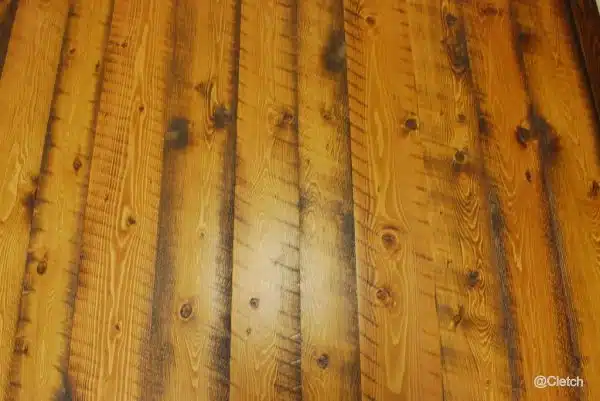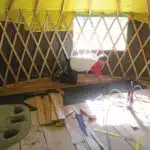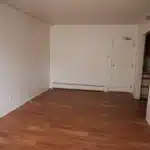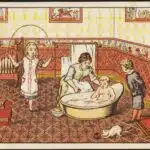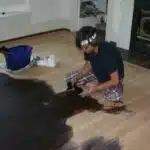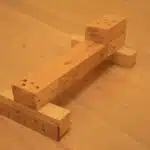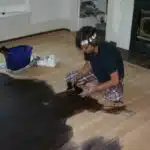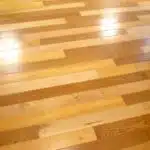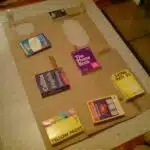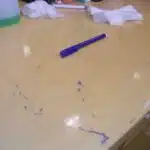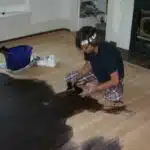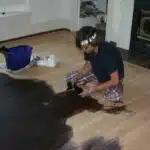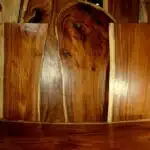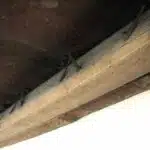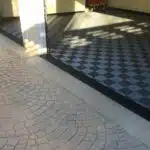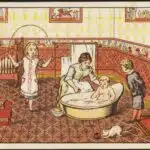Wood floors can add warmth and sophistication to any home, but they require proper care and maintenance to maintain their beauty. Cleaning wood floors can be a daunting task for many homeowners, as using the wrong products or techniques can cause damage to the flooring. In this article, we will explore the best methods for cleaning wood floors, from daily maintenance to deep cleaning.
As a home cleaning expert, it is my passion to help others create a clean and inviting living space. I believe that maintaining a clean home not only benefits our physical health but also our mental wellbeing. Wood floors are an investment in your home, and by following the proper cleaning techniques, you can ensure that they remain beautiful for years to come. Whether you have hardwood floors or engineered wood flooring, this article will provide you with the knowledge and tools necessary to keep your floors looking their best.
Understanding Your Wood Flooring
Wood floors add warmth and beauty to a home, but they require proper care to maintain their appearance. Understanding your wood flooring is the first step to ensuring that it stays in good condition. There are two main types of wood floors: solid hardwood and engineered hardwood. Solid hardwood is made from a single piece of wood and can be refinished several times over its lifespan. Engineered hardwood consists of multiple layers of wood veneer and can only be refinished once or twice.
Another important factor to consider is the type of finish on your wood floor. The most common finishes include polyurethane, wax, and oil-based finishes. Polyurethane finishes provide a protective layer that resists scratches and stains, while wax finishes give the floor a soft sheen and require regular reapplication. Oil-based finishes penetrate the wood for a natural look but may require frequent maintenance.
Understanding the type of wood floor you have and its finish will help you determine how best to clean it without damaging it. It’s also important to note that different cleaning methods may be required for different types of spills or stains. By taking the time to understand your wood flooring, you’ll be able to keep it looking beautiful for years to come. Now let’s move onto some daily maintenance tips for keeping your wood floors clean and shiny.
Daily Maintenance Tips
- Sweeping is an essential part of daily maintenance for wood floors, as it helps remove dirt and debris that can cause scratches and damage.
- Mopping with a damp cloth or mop can help remove dirt that has been ground into the surface, but it is important to avoid saturating the wood.
- Vacuuming with a soft brush attachment is an effective way to remove dirt and debris from the crevices between floorboards.
- It is imperative to use the right products when cleaning wood floors, as using the wrong products can cause surface damage.
- It is advisable to use cleaning products that are specifically designed for wood floors, as they will not strip away the protective sealant.
- Regularly cleaning wood floors can help improve their appearance and extend their lifespan.
Sweeping
Sweeping is an essential part of daily maintenance for wood floors. Proper sweeping techniques can prevent dirt and debris from scratching and damaging the floor’s surface. To achieve optimal cleaning results, it is important to use a soft-bristled broom or a microfiber dust mop. In this way, fine dust particles are captured without leaving behind any scratches.
The frequency of sweeping depends on foot traffic and household conditions. For households with pets or children, it is recommended to sweep daily or every other day. On the other hand, households with low traffic may only need to sweep once or twice a week. Sweeping before mopping is also crucial as it eliminates dirt and debris that can get pushed around during mopping.
By following proper sweeping techniques and adhering to recommended frequency guidelines, wood floors can be kept clean and well-maintained on a daily basis. Not only does this promote aesthetic appeal but it also prolongs the life of the flooring material. A commitment to regular cleaning habits ultimately leads to a healthier living environment for all occupants in the home.
Mopping
To further maintain the cleanliness of wood floors, mopping is an important step to add to one’s daily cleaning routine. While sweeping can effectively remove dirt and debris on the surface, mopping can help get rid of any remaining grime on the floor. There are different methods of mopping, such as steam cleaning or dry mopping, depending on the type of flooring material. For wooden floors, dry mopping is recommended to avoid damage from excess moisture.
When dry mopping a wooden floor, it is essential to use a microfiber mop or a soft cloth that will not scratch the surface. Before starting, ensure that there are no sharp objects or debris on the floor that could potentially cause scratches during the process. To maximize effectiveness, it is advised to work in sections and use gentle pressure when cleaning.
Steam cleaning can also be used for wood floors but should be done with caution as excess moisture can lead to warping or cracking. It is crucial to follow manufacturer’s guidelines when using a steam cleaner and avoid leaving water on the surface for too long. By incorporating proper mopping techniques into one’s daily maintenance routine, wood floors can remain clean and well-maintained for years to come.
Vacuuming
Maintaining the cleanliness of wood floors goes beyond sweeping and mopping. Vacuuming is an essential step to prevent dirt and dust buildup that can lead to scratches or wear on the surface. Proper vacuuming techniques can help prolong the lifespan of wooden floors and keep them looking their best.
When choosing a vacuum for wood floors, it is important to select one with soft bristles or no-brush roll to avoid scratching the surface. The suction power should also be adjustable to prevent excessive force that could damage the floor’s finish. Some of the best vacuums for wood floors include those with HEPA filters that trap allergens and dust particles, making it a great investment for those who are sensitive to indoor air pollutants.
To effectively vacuum wooden floors, start by removing any loose debris such as pet hair, crumbs, or dust using a broom or dry mop. Then use a vacuum with appropriate suction power and no-brush roll attachment to gently remove any remaining dirt without damaging the floor’s finish. Vacuuming should be done at least once a week or more frequently in high traffic areas or homes with pets.
By incorporating proper vacuuming techniques into daily maintenance routines, homeowners can ensure that their wooden floors remain clean and scratch-free for years to come. With the right tools and attention to detail, maintaining wooden floors can be easy and rewarding.
Sweeping Vs. Vacuuming
As we all know, a clean home is a happy home. While daily maintenance tips can keep your floors looking polished and well-maintained, it’s important to choose the right cleaning methods to ensure their longevity. When it comes to cleaning wood floors, there are two main options: sweeping and vacuuming.
Sweeping is an age-old method of cleaning that has been used for centuries. There are many benefits to sweeping your wood floors. For one, it’s a great way to remove dirt and debris without scratching or damaging the surface. Sweeping also allows you to reach into corners and crevices, where dust tends to accumulate. Additionally, sweeping is a low-tech method that doesn’t require any electricity or special equipment.
On the other hand, vacuuming has its own set of pros and cons when it comes to cleaning wood floors. One benefit of using a vacuum cleaner is that it can be quicker and more efficient than sweeping, especially if you have a large area to clean. Many modern vacuum cleaners also come with attachments specifically designed for use on hardwood floors, which can help prevent scratches and damage. However, some vacuums can be too powerful for delicate flooring or may have bristles that can scratch the surface.
When choosing between sweeping and vacuuming your wood floors, it’s important to consider both the benefits and drawbacks of each method before making a decision. Ultimately, the best choice will depend on your personal preferences as well as the type of flooring you have in your home. In our next section, we’ll explore how choosing the right cleaning products can make all the difference in keeping your wood floors looking their best.
Choosing The Right Cleaning Products
When it comes to cleaning wood floors, choosing the right cleaning products is crucial. Not all products are created equal, and some can actually damage your floors. One option to consider is eco-friendly products. These products are made with natural ingredients that are safe for both your family and the environment. Look for cleaners that are labeled as non-toxic, biodegradable, and phosphate-free.
Before using any new product on your wood floors, it’s important to test it on a small area first. This will help you determine if the product is safe for use on your particular type of flooring. Apply a small amount of the cleaner to an inconspicuous spot and wait a few minutes before wiping it away. If there is no discoloration or damage to the surface, then it should be safe to use throughout the rest of your flooring.
By choosing eco-friendly products and testing them before use, you can ensure that your wood floors stay clean without causing harm to your home or the environment. In the next section, we will explore another option for cleaning wood floors- homemade cleaning solutions. These solutions can be just as effective as store-bought cleaners, but with the added benefit of being cost-effective and customizable.
Homemade Cleaning Solutions
Cleaning your wood floors is essential to maintaining their beauty and longevity. While there are many commercial cleaning products on the market, some people prefer to create DIY cleaning recipes using natural cleaning methods. These homemade cleaning solutions can be just as effective as store-bought products and are often more affordable.
One popular homemade solution for cleaning wood floors is a mixture of equal parts water, vinegar, and rubbing alcohol. This recipe not only cleans the surface of the floor but also helps to disinfect it. Simply mix the ingredients in a spray bottle and apply to your floors with a mop or cloth.
Another effective option is a mixture of warm water and dish soap. This solution is gentle on your floors while still providing a deep clean. Mix one tablespoon of dish soap with one gallon of warm water, then use a mop or cloth to apply the solution to your floors. Rinse thoroughly with clean water and allow the floors to air dry.
When it comes to keeping your wood floors looking their best, DIY cleaning recipes offer an affordable and natural alternative to commercial cleaning products. By using these natural cleaning methods, you can maintain your floors’ beauty while also reducing your exposure to harsh chemicals. In the next section, we will discuss spot-cleaning stains on wood floors for those tough-to-remove spots that need extra attention.
Spot-Cleaning Stains
- Removing spills from wood floors requires prompt action and the use of a damp cloth to avoid long-term staining.
- Blotting stains from wood floors requires the use of a clean white cloth and gentle pressure to absorb the stain.
- Cleaning solutions for wood floors should be carefully chosen to avoid damage to the finish or the wood itself.
- Depending on the type of spill, mild soap and water or a commercial cleaner may be the best choice for spot-cleaning.
- It is important to avoid harsh chemicals when spot-cleaning wood floors, as they may damage the finish and the wood itself.
- When spot-cleaning wood floors, it is important to use a damp cloth and mild cleaning solution to avoid further damage to the wood or finish.
Removing Spills
Removing spills from wood floors can be a daunting task, especially when dealing with pet stains or greasy spills. If left unattended, these types of spills can cause permanent damage to the wooden surface. To remove pet stains, start by blotting up any excess liquid with a clean cloth. Then, mix equal parts white vinegar and warm water and apply it to the affected area. Let it sit for a few minutes before wiping it away with a damp cloth.
Greasy spills can also pose a challenge when cleaning wood floors. The first step is to use a dry cloth or paper towel to soak up as much of the grease as possible. Next, mix a small amount of dish soap with warm water and apply it to the stain using a clean cloth. Be sure to avoid using too much water which can seep into the crevices of the wood and cause damage. Once the stain has been removed, rinse the area thoroughly with clean water and dry it immediately.
In conclusion, removing spills from wood floors requires immediate attention in order to prevent permanent damage from setting in. Whether dealing with pet stains or greasy spills, there are simple methods that can be used to effectively remove them without causing further harm to the wooden surface. By following these tips and taking proper care of your wood floors on a regular basis, you can ensure they remain beautiful and long-lasting for years to come.
Blotting Stains
When it comes to maintaining the beauty of your wooden floors, it is important to know how to spot-clean stains. One of the most effective techniques for removing tough stains is using blotting methods. Blotting helps to absorb liquids without spreading them further across the floor, which can make the stain worse.
To begin, it is essential to act quickly when a spill occurs. The longer a stain sits on the wood surface, the more difficult it will be to remove. When blotting stains, start by using a clean cloth or paper towel to gently absorb any excess liquid. Avoid rubbing or pressing too hard as this can push the stain deeper into the wood fibers.
Once you have removed as much liquid as possible, use a damp cloth or sponge and apply gentle pressure while blotting the affected area. Be sure not to saturate the wood with water as this can cause warping and other damage over time. With persistent blotting and patience, stubborn stains can often be removed without causing harm to your beautiful hardwood floors.
Cleaning Solutions
As a home cleaning expert, it is important to know how to effectively spot-clean stains on your hardwood floors. While blotting can be helpful in removing excess liquid, sometimes it may not be enough to fully remove the stain. That’s where DIY cleaning solutions come in handy.
When it comes to DIY cleaning solutions for hardwood floors, natural ingredients are often the best choice. Not only are they safer for the environment and your family, but they can also be just as effective as store-bought cleaners. For example, a mixture of water and vinegar can be used to tackle tough stains like pet urine or red wine. Simply mix equal parts water and vinegar in a spray bottle and apply directly to the stain. Let it sit for a few minutes before gently blotting with a clean cloth or paper towel.
Another effective natural solution is baking soda mixed with water. This paste can be applied directly to stubborn stains and left to sit for several minutes before wiping away with a damp cloth. It’s important to note that regardless of which DIY cleaning solution you choose, always test it on an inconspicuous area of your floor first before applying it to larger stains or areas. With these simple yet effective natural solutions, your hardwood floors can stay beautiful and spotless for years to come.
Preventing Water Damage
Wood floors are a beautiful addition to any home, but they can be vulnerable to water damage if not properly cared for. Using rugs in high traffic areas can help prevent water damage by catching any spills or drips before they reach the floor. It’s important to choose rugs with a non-slip backing to prevent slips and falls.
Proper drying techniques are also crucial in preventing water damage to wood floors. Any spills or leaks should be cleaned up immediately using a dry cloth or mop. If there is standing water on the floor, use a wet vac to remove as much moisture as possible. After cleaning up the spill, use fans or open windows to promote air circulation and aid in drying.
Preventive measures are also key in avoiding water damage to wood floors. Place waterproof mats under potted plants and make sure any appliances that use water, such as washing machines and dishwashers, are properly sealed and maintained. Regularly inspect plumbing fixtures for leaks and have them repaired promptly if necessary.
Remember that prevention is the best defense against water damage on wood floors. By using rugs, proper drying techniques, and taking preventive measures, you can keep your floors looking their best for years to come.
To avoid scratches and scuffs on your wood floors, there are several steps you can take.
Avoiding Scratches And Scuffs
Preventing water damage is a crucial step in maintaining the quality of your wood floors. However, scratches and scuffs are also common issues that need to be addressed. These blemishes can significantly detract from the beauty of your wooden floorings. To keep them looking their best, it’s essential to learn about buffing techniques and waxing methods.
Buffing techniques can be used to remove minor scratches and scuffs from your hardwood floors. It involves using a buffing machine with a soft pad that rotates at a high speed. This method gently removes the topmost layer of the hardwood surface, smoothing out any imperfections on the floor’s surface. Buffing should be done periodically to maintain the shine and luster of your wood flooring.
Waxing is another effective way to protect your wooden floors from scratches and scuffs. A coat of wax provides a protective layer on top of the wood, which helps prevent dirt and debris from getting trapped in the pores of the wood. It also provides an extra layer of protection against spills and stains. Applying wax can be quite tricky, so it’s essential to follow proper instructions carefully.
Moving forward, removing gum and adhesive residue can be challenging if not dealt with properly. But don’t worry – there are ways to do it effectively without damaging your wood flooring. Let’s move on to our next section where we’ll discuss tips for removing stubborn gum and adhesive residue from your beautiful wooden floors!
Removing Gum And Adhesive Residue
- Removing gum from hardwood floors requires a careful approach to ensure the flooring isn’t damaged.
- The first step is to take a plastic scraper to remove as much of the gum as possible.
- To remove any residue, a mixture of warm water, white vinegar, and mild dish soap can be used.
- To remove adhesive residue, a product specifically designed for this purpose should be used as it will be more effective and won’t damage the flooring.
Removing Gum
Removing Gum from Wood Floors
Gum can be a stubborn mess to remove from wood floors. However, it is not impossible to do so without causing damage to the surface of your flooring. To begin with, use a plastic scraper to gently scrape away as much of the gum as possible. Then, use ice cubes in a plastic bag and place it over the remaining gum for several minutes until it hardens. Use the plastic scraper again to remove the hardened gum carefully.
Preventing Gum from Sticking to Wood Floors
Prevention is always better than cure when it comes to cleaning gum off wood floors. One way of preventing gum from sticking onto your flooring is by having a ‘no-gum’ policy in your home or office space. Make sure that everyone knows this rule and understands its importance. Additionally, you can place mats at entrances and exits to prevent any dirt or debris that may contain gum from entering your home or office space.
In conclusion, removing gum from wood floors requires patience and care, but it is doable. It’s best to prevent gum from sticking onto wood floors by implementing rules like the ‘no-gum’ policy and placing mats at entrances and exits. By following these steps, you can ensure that your wood flooring remains in top-notch condition for years to come.
Removing Adhesive Residue
When it comes to keeping your home or office space clean, removing gum and adhesive residue can be a challenging task. While we have previously discussed how to remove gum from wood floors, another common problem is adhesive residue. Adhesive residue is often left behind after removing stickers or tape from surfaces, and it can be frustrating to remove without damaging the surface. Fortunately, there are several effective methods for removing adhesive residue that you can try in your home.
One way of removing adhesive residue is by using solvents such as rubbing alcohol or nail polish remover. Apply a small amount of the solvent onto a clean cloth and rub it onto the adhesive residue until it dissolves. Be sure to test the solvent on a small area first to ensure that it does not damage the surface. Another option is steam cleaning, which uses hot water vapor to break down and loosen the adhesive residue. This method works well for larger areas or delicate surfaces where solvents may cause damage.
It’s important to note that when removing adhesive residue, patience and care are key. Avoid using harsh chemicals or abrasive tools that could scratch or damage the surface. Instead, opt for gentle methods like solvents or steam cleaning that will effectively remove the residue without causing further damage. By following these tips, you can keep your home or office space looking clean and free of pesky adhesive residue!
Deep Cleaning Techniques
There is a popular notion that steam cleaning is not suitable for wood floors. However, this belief is not entirely true. Steam cleaning can be used to clean wood floors effectively if done correctly. The key is to use only a small amount of water and the right temperature setting. Too much moisture can cause damage to the floor’s finish or warp the wood.
Another technique that can be used for deep cleaning wood floors is buffing. Buffing involves using a machine with soft-bristled brushes or pads to remove dirt and grime from the floor’s surface. It also helps to restore shine to dull-looking floors. Before using this method, it’s essential to ensure that the floor is free of any debris or loose particles that may scratch its surface.
When using either of these techniques, it’s crucial to follow proper safety precautions and manufacturer’s instructions carefully. Failure to do so may result in damage or injury. In addition, always test any cleaning solution or product on a small, inconspicuous area before applying it to the entire floor.
Transition into the subsequent section about professional floor cleaning services:
While steam cleaning and buffing techniques are effective for deep-cleaning your wood floors at home, sometimes you need professional help in maintaining their appearance and prolonging their lifespan. Professional floor cleaning services offer various options for maintaining your floors’ cleanliness and shine while ensuring their protection against potential damage caused by improper treatment techniques.
Professional Floor Cleaning Services
While cleaning your floors by yourself is a great way to maintain their cleanliness, sometimes professional help can provide benefits that you simply cannot achieve on your own. Professional floor cleaning services offer a range of benefits, including saving time and effort while ensuring a thorough clean. In addition, professional cleaners have the necessary equipment and experience to handle even the toughest stains.
One of the biggest advantages of hiring professional floor cleaners is cost effectiveness. While it may seem like an unnecessary expense, investing in regular professional cleaning can actually save you money in the long run. With proper maintenance, your floors will last longer and require fewer repairs or replacements. Additionally, professional cleaners use high-quality products and techniques that are designed to protect your floors from future damage.
When it comes to choosing a professional floor cleaning service, there are several factors to consider. Look for a company with experienced technicians who are trained in the latest techniques and equipment. Additionally, choose a company that offers flexible scheduling options and transparent pricing. Finally, read customer reviews to ensure that you are getting the best possible service for your money.
In conclusion, hiring professional floor cleaners can provide numerous benefits for homeowners looking to maintain their floors’ quality without sacrificing time or effort. Furthermore, these services offer cost effectiveness by extending the life of your flooring and reducing repair costs over time. If you’re interested in refinishing and restoring your floors after they have been cleaned professionally, read on for our expert tips on how to get started!
Refinishing And Restoring Your Floors
When it comes to refinishing and restoring wood floors, there are a few things you need to keep in mind. First and foremost, you’ll want to determine the type of wood your floors are made from. Different types of wood require different levels of attention, so knowing what kind of wood you’re working with is essential. Once you’ve identified your wood species, it’s time to move on to sanding.
Sanding your wood floors is a critical step in the restoration process. When sanding, it’s important to start with a coarse grit sandpaper and work your way up to finer grits gradually. The grit you should use will depend on the condition of your floors; for example, if there are deep scratches or dents in the floor, you’ll want to start with a lower grit sandpaper such as 60 or 80. As you progress through sandpaper grits, your goal is to smooth out any rough patches and remove any remaining finish.
Once your floors have been sanded down to their natural state, it’s time to consider staining options. You can choose from a variety of stains that range from light browns all the way up dark espresso colors. Before applying any stain, it’s essential that you clean off any dust left over from sanding. After cleaning off the dust, apply the stain evenly across the surface of the floor using a brush or roller. Allow each coat of stain ample time for drying before adding additional coats.
| Sandpaper Grit | Use |
|---|---|
| 60-80 | For removing deep scratches or dents |
| 100-120 | For smoothing out rough patches |
| 150-180 | For preparing the floor for staining |
In preparation for caring for engineered wood flooring, it’s important that you understand how to refinish and restore solid hardwood flooring properly first. This knowledge will give you an excellent foundation upon which you can build to care for your engineered wood floors. With the right tools and techniques, you can restore your hardwood floors to their former glory and enjoy years of use out of them.
Caring For Engineered Wood Flooring
Engineered wood flooring requires regular and careful maintenance to ensure a long life. To clean engineered wood floors, it is recommended to use a mild detergent and vacuum or sweep regularly. To maintain engineered wood floors, avoid harsh chemicals and use a non-abrasive floor cleaner. Lastly, a UV-protective finish should be applied every few years to prevent damage from sunlight.
Cleaning Engineered Wood Floors
To maintain the beauty and longevity of your engineered wood floors, cleaning is a crucial part of the equation. Cleaning engineered wood floors is not as daunting as it may sound, but using the right cleaning solution and method can make all the difference. When cleaning your engineered wood floors, avoid using harsh chemicals or abrasive materials that can scratch or damage the surface. Instead, opt for a gentle cleaning solution that is specifically designed for use on hardwood floors.
One effective way to clean engineered wood floors is by using microfiber cloths. These cloths are specially designed to attract and trap dust and dirt particles without scratching or damaging the floor’s surface. Simply dampen a microfiber cloth with your chosen cleaning solution and gently wipe down your floors. Be sure to wring out excess water before wiping to avoid leaving any standing water on your floors.
Regularly cleaning your engineered wood floors not only keeps them looking beautiful but also helps extend their lifespan. By following these simple steps and using the right tools and products, you can keep your engineered wood floors looking their best for years to come. Remember to always test any new cleaning product on an inconspicuous area of your floor before applying it across the entire surface.
Maintaining Engineered Wood Floors
Maintaining engineered wood floors is essential to ensure their longevity and beauty. One of the most important aspects of maintenance is preventing warping, which can occur when the floor absorbs too much moisture. To avoid this, it’s crucial to clean spills immediately and to use a dehumidifier in areas with high humidity. Additionally, it’s best to avoid dragging heavy furniture across the floor and using protective pads under furniture legs.
In addition to preventing warping, regular cleaning is necessary for maintaining engineered wood floors. As mentioned before, microfiber cloths are an effective tool for gentle cleaning without causing scratches or damage. It’s also important to vacuum or sweep regularly to remove dirt and debris that can scratch the surface. When using a vacuum, make sure it has a hardwood floor attachment or setting.
Another aspect of maintenance involves refinishing the floors every few years to restore their appearance and protect them from wear and tear. This process involves sanding down the top layer of finish and applying a new coat of sealer or stain. Hiring a professional for this task may be beneficial as they have the expertise and tools needed for a successful refinishing job.
By following these tips for maintaining engineered wood floors, homeowners can ensure their flooring lasts for many years while maintaining its natural beauty.
Maintaining Laminate Wood Floors
Laminate wood floors are a popular choice among homeowners for their durability and affordability. However, to ensure that they last for many years, proper maintenance is crucial. Here are some tips on how to maintain your laminate wood floors:
Regular Cleaning: Dust and debris can scratch the surface of your laminate wood floors, so it’s important to sweep or vacuum them regularly. Avoid using wet mops as excess water can cause damage to the floorboards. Instead, use a microfiber mop or cloth dampened with a small amount of water or a specialized laminate cleaner.
Protective Coatings: Applying protective coatings such as wax or polyurethane can help prevent damage from spills and scratches. However, it’s important to only use products that are specifically designed for use on laminate wood floors. DIY repairs can also be done using repair kits available in hardware stores.
Overall, maintaining your laminate wood floors isn’t difficult but it does require consistency and attention to detail. By following these tips and being proactive about cleaning and protecting your floors, you’ll be able to enjoy beautiful flooring for years to come.
Transition: Now that we’ve covered some basic tips for maintaining laminate wood floors let’s move onto troubleshooting common issues that may arise over time.
Troubleshooting Common Wood Floor Issues
Wood floors are beautiful and add an elegant touch to any home. However, they are also prone to issues that can be frustrating for homeowners. One of the most common problems is warping. Warping occurs when the wood absorbs too much moisture, causing it to expand and contract. This can lead to gaps between the boards, buckling, and even cracking.
To prevent warping, it is important to regulate the humidity levels in your home. Use a dehumidifier in humid areas or during humid months, and a humidifier during dry months or in dry climates. Additionally, avoid using wet mops or leaving spills on the floor for extended periods of time. Always clean up spills immediately with a dry cloth.
Another common issue with wood floors is squeaking. Squeaks occur when there is movement between the subfloor and the hardwood planks above. To fix squeaks, start by locating the source of the noise by walking around barefoot until you hear it. Once you have located it, sprinkle talcum powder or baking soda over the area and sweep it into the cracks between the boards with a soft-bristled brush. This will help lubricate the area and reduce friction.
In conclusion, preventing warping and fixing squeaks are two common issues that homeowners face when dealing with wood floors. By regulating humidity levels and taking preventative measures like cleaning up spills immediately, you can prevent warping from occurring in your floors. And if you do experience squeaking, use talcum powder or baking soda to lubricate the area and reduce friction between boards. With these tips in mind, you can keep your wood floors looking beautiful for years to come.
Conclusion
Wood flooring is a beautiful addition to any home, but it requires proper care and maintenance to preserve its beauty and longevity. Understanding the type of wood flooring you have is essential in determining the best cleaning methods for your floors. Daily maintenance, such as sweeping or vacuuming, can help prevent scratches and damage to your floors. Choosing the right cleaning products, including homemade solutions, can also make a significant difference in keeping your floors looking their best.
If your wood floors require more intensive cleaning, refinishing or restoring may be necessary. It’s important to care for engineered wood flooring differently than traditional hardwoods and laminate wood floors require unique maintenance as well. Troubleshooting common issues like scratches or water damage can also save you money in costly repairs down the line.
By following these tips and techniques, you can keep your wood floors looking their best for years to come. Remember to always consult with a professional or manufacturer’s recommendations before attempting any major refinishing or restoration projects on your own. With proper care and attention, your wood floors will continue to be a cherished feature in your home for generations.
Image Credits
- “Wood Floors” by cletch (featured)

